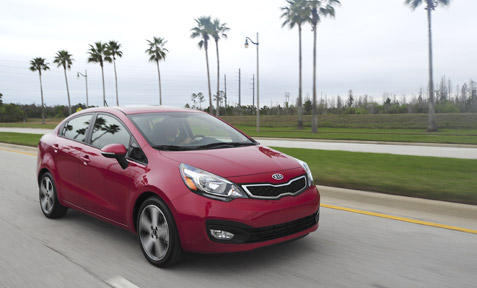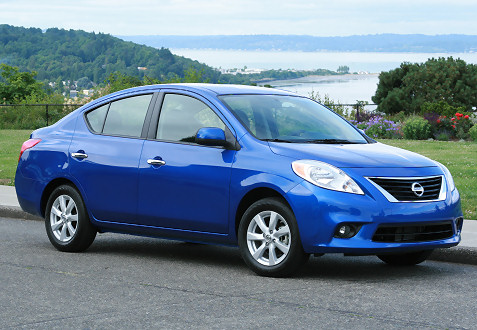5 Global Cars with Excellent Gas Mileage
Posted by Bullz-Eye Staff (12/11/2013 @ 9:26 am)
With the onset of the credit crunch and increased fuel prices, motorists are increasingly seeking out vehicles with long term affordability and lower running costs. Where once looks and performance played a major role in choosing a new car, in recent years this has often been replaced by questions about reliability, low service cost and good fuel economy. Manufacturers have played an important part by employing new and improved technologies to not only meet ever-demanding emissions standards and Green agendas but also to improve fuel consumption and make their vehicles more attractive to the discerning buyer. This article features five cars that top the tree when it comes to fuel economy.
Kia Rio
At one time Kia was viewed as very much a low-budget, inferior-quality alternative to more traditional manufacturers, but in recent years the company has evolved into one the world’s foremost automotive companies. With vehicles boasting a surprisingly high level of equipment and a wide range of options, the Kia Rio has undergone several incarnations. The most recent ‘Ecodynamics’ versions boast extremely frugal petrol and diesel engines, with some models claiming fuel economy approaching 90 miles per gallon (mpg). This is one small car not be overlooked.

Toyota Yaris Hybrid
Toyota are renowned for launching the world’s first mass-produced hybrid, the Prius, and have now extended the technology across the range. The Yaris, already a very fuel efficient and highly-respected supermini, is now available as a hybrid, and boasts economy in the range of 80 mpg. There’s an added premium to pay for the car, but the accompanying lowered emissions and great economy make this a terrific vehicle.
Citroen C3
Another car which has been refined over the past few years, the C3 ‘Airdream’ model can attain a fuel economy around 83 mpg, and features many of the associated benefits in lowered emissions and comfort as its immediate competitors. With low provisional insurance and new driver costs, coupled with its great environmental credetials, this is a very worthy contender among the most efficient and economical cars in its class.
Renault Clio
The Clio has been around for many years, and is extremely familiar to the UK market thanks to an impressive marketing campaign in the 1990s. The bolted-on ECO credentials have once again put the Clio to the fore, with the latest models reputedly rivalling the Kia Rio’s 88 mpg performance level at a very similar cost. In a market consistently dominated by Far Eastern vehicles, the French are definitely catching up again.
Chevrolet Volt
No look at the most economical vehicles on the road would be complete without mention of the remarkable Chevrolet Volt, and its sister car, the Vauxhall Ampera. One of the first truly next-generation cars to hit the market, the Volt is the European Car of the Year 2013. It boasts an electric battery with relatively limited range, but with a petrol-powered electricity generator as backup, tests have reportedly shown that the Volt can, remarkably, produce fuel consumption of 235 mpg!

As new technologies are introduced into the market, no doubt fuel economy among all classes of car will continue to improve. The five examples above demonstrate that fantastic fuel savings can be made without compromising great performance and comfort, and have ushered in a new era in car manufacturing.
The benefits of a small car
Posted by Bullz-Eye Staff (11/29/2013 @ 8:52 am)

So ol’ Betsey just isn’t cutting it anymore? She splutters for five minutes when you start her up and she struggles going up the slightest of inclines. It’s always been a love/hate relationship, but you’ve now come to the conclusion of I need a new car. Congratulations, and welcome to the market! So what’s your new investment? Are you at a crossroads, jumping between going big or small? Purchasing a car is a big deal and deciding on the right car for you is important. Besides considering the make, model, year, and price, consider the size of the car. There are many benefits to owning a small car; they are no longer the econoboxes of yesteryear. Small automobiles now give the big boys a run for their money in terms of design, technology, space and durability. Here is just a few reasons as to why your next car should be downsized.
Parking and Storage
Besides taking on sand dunes and muddy hills, everything is easier in a small car. You can glide into practically every parking space with ease, unless you’re a completely incompetent driver, and in that case, you should have never got your licence. Jokes aside, small cars are ideal for those living in a built up urban areas with limited parking spaces. Unlike an SUV, a small car will easily fit into narrow garages allowing for additional storage after parking your car.
Less Gas = More Mileage
The main disadvantages commonly found with a large car is that they are massive gas guzzlers. Considering petrol is pushing $3.50 a gallon, an extra $100 in mileage on top of your weekly car repayments really hurts the hip pocket. A small car is the complete opposite. Not only will you have to fill up less frequently, but when you do, you’ll have no fear in doing a happy dance when you notice that the pump doesn’t spin over $100.
Cheaper to Maintain
Servicing your car is something not many people look forward to, especially if you think your mechanic is going to charge you an arm and a leg. Small cars like Ford Fiesta and Focus offer an abundance of maintenance saving opportunities, starting with the simplicity of how the car is built; smaller car means less time in the garage and hardly any fussing about for you. Unlike a large vehicle, it’s rare that you will have to spend more than $1,000 of a set of new tyres, and any spare parts you might need will be significantly cheaper.
Packed With Technology
Technology is no longer limited to luxury vehicles and large cars. Carmakers are now free to cram every high tech gadget at their disposal into these downsized chariots. In a new model, you’ll likely find in-dash navigation systems, hard-drive based entertainment units, in-car communication offerings, smartphone integration, heated seats…. Oh and multiple cup holders. Under no circumstances can you neglect the practicality of numerous cup holders.
What do you look for when purchasing a new car? Would you go for a large car or a small one? Tell us in the comments below.
First Drive: 2012 Nissan Versa
Posted by Gerardo Orlando (07/28/2011 @ 11:50 am)
Seattle is usually spectacular in the summer, as the gray skies and drizzle is replace by clear and crisp summer days. So I was pleased to hear we’d be driving the redesigned 2012 Nissan Versa in the Great Northwest in July. The weather cooperated for the most part and I was able to test the pre-production vehicles in both city and highway settings while taking in some of the sights around Seattle.
Exterior
Nissan has completely redesigned the 4-dour Versa for 2012, while the update for the 5-door hatchback will come a little later. The new Versa is the first Nissan model to sport the new front grille for sedans, which is a huge improvement over the previous Nissan grille. That combined with the stylish headlights completely changes the look of the vehicle. It’s more polished and elegant that its predecessor, giving off the impression of a more expensive sedan. The previous model had a more vertical feel to it, while the new Versa has a much more aerodynamic look.
The lines of the new Versa are clean and sophisticated, and this will appeal to small car buyers who are turned off by the edgier designs from competitors that are common in the compact segment. I was impressed by the look of the car from all angles as I walked around it.
Interior
The interior was roomy and comfortable. The interior comes in two colors, charcoal and sandstone, and both fit nicely with the new exterior design. Again, consumers who prefer a more elegant vehicle over an edgy design will be pleased with the new Versa. It’s also very roomy in the back seat and has best in class trunk space, making it very practical for buyers who expect to have passengers and cargo.
Performance
The Versa features a continuously variable transmission (CVT), so you won’t feel gear changes as you’re driving the vehicle and accelerating. The new Versa sports Nissan’s second-generation CVT design, improving fuel mileage over the previous model by 5 MPG. The Versa now gets 30 MPG City, 38 MPG Highway and 33 MPG combined. Nissan official stressed that the combined mileage was tied for best-in-class, as the CVT provides great mileage performance in city driving. It also features a new 1.6-liter engine with 109 horsepower @6,000 rpm and 107 lb-ft of torque at @4,400 rpm.
I liked how the Versa felt, particularly in city driving where the CVT performed nicely. It has competitive power for vehicles in this class and solid handling.
Overview
The 1st generation Versa was introduced in 2006 and was the U.S. segment share leader for the in 2010. The small car segment is growing rapidly as more buyers look for fuel economy, and with this update we can expect the Nissan Versa to continue to be a sales leader in this space. Consumers will have many choices as more brands enter this space, and the new design will appeal to many consumers drawn to a more elegant look. It will appeal to many younger buyers and consumers looking for a commuter vehicle.
The Versa has the lowest standard MSRP of any vehicle in this space at $10,990 for the S MT. This entry-level model has few options and has a manual transmission instead of the CVT but is equipped with standard air conditioning and a radio. The S CVT starts at $12,760, the SV CVT starts at $14,560 and the SL CVT starts at $15,560, and you can add a Tech Package with Navigation, XM radio and USB for an additional $700.
Posted in: Car Reviews, Cars, Lifestyle, On Location
Tags: car reviews, compact cars, continuously variable transmission, first drive, first drive reviews, fuel mileage, MPG, nissan, Nissan Versa, Seattle, small cars

























